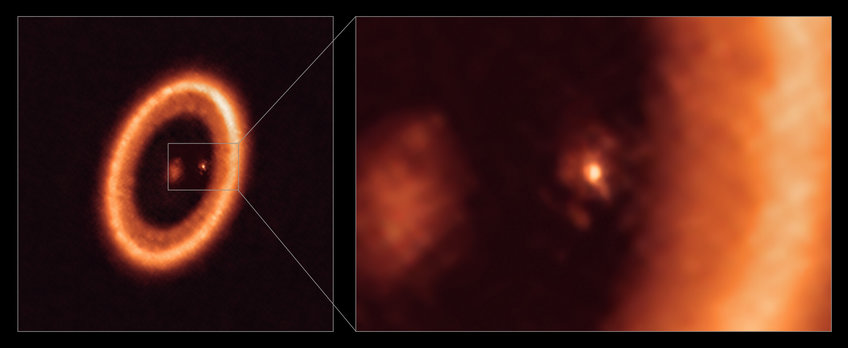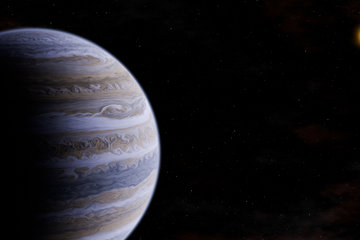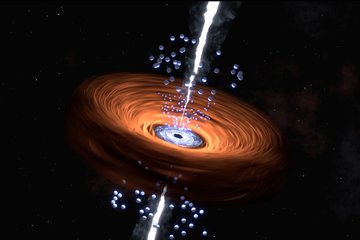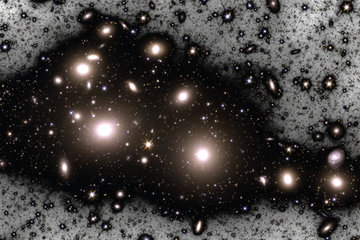The birth of exomoons
A distant planet is surrounded by material from which at least one satellite could form
An international group of researchers, including astronomers from the Max Planck Institute for Astronomy in Heidelberg, have for the first time unambiguously detected a disk of dust around a planet outside our solar system. The observations from the Atacama Large Millimetre/Submillimetre Array (ALMA), in which the European Southern Observatory is a partner, will provide new insights into how moons and planets form in young planetary systems.

The formation of the Earth’s moon has been a topic of scientific discussion time and again and is still not fully understood. Even more so, astronomers are keen to study the formation of natural satellites around distant exoplanets to find out their formation mechanisms. Now, for the first time, scientists have clearly discovered a disk around a Jupiter-like exoplanet that bears the potential to produce moons.
“Our work presents a clear detection of a disk in which satellites could be forming,” says Myriam Benisty, a researcher at the University of Grenoble, France, and at the University of Chile. She led the new research published today in The Astrophysical Journal Letters. “We obtained our ALMA observations at such excellent resolution that we could identify without a doubt that the disk is associated with the planet, and we are able to constrain its size for the first time,” she adds.
The disk in question, called a circumplanetary disk, surrounds the exoplanet PDS 70c. It is one of two giant, Jupiter-like planets orbiting a star nearly 400 light-years away. Astronomers had found hints of a “moon-forming” disk around this exoplanet before but, since they could not clearly tell the disk apart from its surrounding environment, they could not confirm its detection — until now.
In addition, the team found that the disk has about the same diameter as the distance from our Sun to the Earth. It incorporates enough mass to form up to three satellites the size of the Moon. However, the results are not only key to finding out how moons arise. These new observations are also essential to prove theories of planet formation that have escaped testing so far.
Planets form in dusty disks around young stars, carving out cavities as they gobble up material from this circumstellar disk to grow. In this process, a planet can acquire its own circumplanetary disk, contributing to the planet’s growth by regulating the amount of material falling onto it. At the same time, the gas and dust in the circumplanetary disk can come together into progressively larger bodies through multiple collisions, ultimately leading to the birth of moons.
Still, astronomers do not yet fully understand the details of these processes. It is still unclear when, where, and how planets and moons form. “We know of more than 4000 exoplanets to date, but all of them populate mature systems. PDS 70b and PDS 70c, which form a system reminiscent of the Jupiter-Saturn pair, are the only two exoplanets detected so far that are still in their stage of formation,” explains Miriam Keppler, a researcher at the Max Planck Institute for Astronomy (MPIA) in Heidelberg, Germany and one of the co-authors of the study.
PDS 70b and PDS 70c, the two planets making up the system, were first discovered using ESO’s Very Large Telescope (VLT) in 2018 and 2019, respectively. Their unique nature means they have been observed with other telescopes and instruments many times since.
The latest high-resolution ALMA observations have now allowed astronomers to gain further insights into the system. In addition to confirming the detection of the circumplanetary disk around PDS 70c and studying its size and mass, they found that PDS 70b does not show clear evidence of such a disk. This result indicates PDS 70c deprived it of dust material in its natal environment.
Thomas Henning, MPIA Director and also co-author of this study, concludes: “In the last two decades, we have discovered planet-forming disks around young stars. Now we are taking on the new challenge of studying the disks around young planets. Our ALMA observations of circumplanetary disks are a big step in this direction.”
MN / HOR












